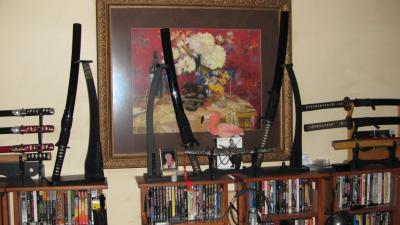Recent Articles
-
Christmas Sword Buying Guide 2025
Dec 03, 25 10:53 PM
- Home
- Maintenance & Repair
- Sword Care Questions
- In your personal opinion, best maintenace & repair tools?
In your personal opinion, best maintenace & repair tools?
by B.A.Miron
(Danbury, CT 06810 USA)

the library
QUESTION: We have not written in a litle while due to all the broken computers we have had to fix.......i could not leave the house for 11 days in a row just to keep up, for example.
........however, what do you all think are the best sharpening stones? (yes, we bought the accusharp as per suggestion by the teacher, we find that it sometimes works a little better if we tilt it a bit on cheaper blades or blades with edges we have had to produce by filing, we have not had to use it on the cheness, or musashis as yet & are afraid)
..........also, what files, hammer, etc. do we like?.....in other words, favorite handtools? & anything else anyone has time to reveal.
.......we just ordered the musashi asuka tanto & the ryumon folded tanto..........how do we test them for blade integrity?, we are aware from this site, that they vary. (everything useful & true about blades that we know comes from this site & a few related to it)
so, hopefully, we have kissed enough behind & bowed low enough to get some useful & valuable advice (nothing else could be true).......also, we enjoy bowing & kissing behind......so there.
ANSWER: Well, you know what they say - flattery will get you everywhere.. Lol.
But seriously, the best sharpening stones are of course the Japanese waterstones - however as just one of these can cost as much as a Cheness Katana, they are really only recommended for use in the hands of experts to be used on very (very) expensive swords.
Personally, I am of the opinion that 'anything that will do the job' is good enough. For me - I use one of those spongy abrasive paper covered blocks, a sanding block, normal files, 3M Abrasive paper in various grits (Coarse, Medium and Fine) the trusty Accusharp and just mix and match as the need arises. A clamp is a must, as is a small hammer and a blunted nail to remove the mekugi (I hate the small brass hammers, the cheap ones always spin around on the thread like a scene from the 'exorcist', so I just use a blunted nail and small hammer).
Now as to testing the lower end swords for integrity - there are a few things to try out. First is a close examination of the blade, looking for any obvious cracks or strangeness, followed by checking the tightness of the fittings for rattling, looseness or anything that doesn't feel right. Often a few hard swings, making sure that everyone is clear away should the worst case scenario occur - will let you know of any problems.
If you know what you are doing, disassembling the sword is a good idea - if you don't know, doing so can actually cause damage...
So that leaves only two ways to continue to evaluate it. The first is to always assume the worst, and to start off with some very light targets - always trying to be aware of where the blade may end up if something catastrophic happens.
The second way is to adopt the same philosophy but push the sword reasonably hard to see what it can handle. Not so hard that you will cause stress fractures in the steel, but hard enough so that you will get an idea of how strong the assembly is and that the blade isn't going to fail suddenly.
The best advice I can give is to read alot (online and offline), learn as much as you can and gain as much experience as possible. But as you learn, a healthy dose of skepticism and not fully trusting the sword is the safest and best policy to adopt. :-)
Hope this helps.
- Paul
Comments for In your personal opinion, best maintenace & repair tools?
|
||
|
||
|
||
|
||

Buying Swords Online Can Be DANGEROUS!
Find the Best Swords in the:
Popular & Recommended ARTICLES

The ONLY true free online magazine for sword enthusiasts. Delivered once a month on the 1st day of the month, no filler and no BS, just the latest sword news & info delivered straight to your inbox.












